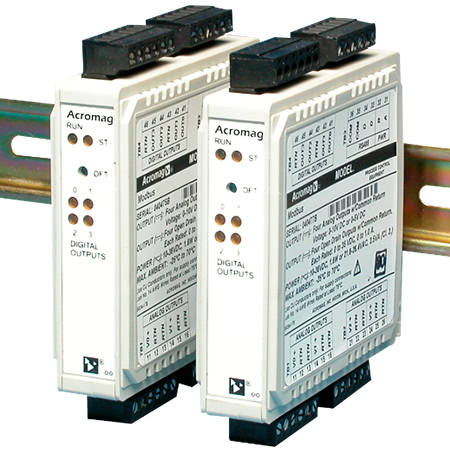The Modbus Protocol was developed in 1979 by Modicon, Incorporated (purchased by Schneider Electric). It was for use in industrial automation systems and Modicon programmable controllers. It has since become an industry standard method for the transfer of discrete/analog I/O information and register data between industrial control and monitoring devices. Modbus is now a widely accepted, open, public domain protocol that requires a license.
How Modbus Operates
Modbus devices communicate using a master slave (client server) technique in which one device (the master/client) can initiate transactions (called queries). The other devices (slaves/servers) respond by supplying the requested data to the master or by taking the action requested in the query. A slave is any peripheral device (I/O transducer, value, network drive or other measuring device) which processes information and sends its output to the master using Modbus. The Acromag I/O Modules from slave/server devices, while a typical master device is a host computer running appropriate application software. Other devices may function as both clients (masters) and servers (slaves).
Firstly, masters can address individual slaves or can initiate a broadcast message to all slaves. Slaves return a response to all queries addressed to them individually, but do not respond to broadcast queries. Slaves do not initiate messages on their own. They only respond to queries from the master.
A master’s query will consist of a slave address (or broadcast address) a function code defining the requested action, any required data and an error checking field. A slave’s response consists of fields confirming the action taken any data to be returned and an error checking field. Note that the query and response both include a device address, a function code, plus response contains the data as requested. If an error occurs in the query received or if the slave is unable to perform the action requested. The slave will return an exception message as its response (See Modbus Exceptions). The error check field of the slave’s message frame allows the master to confirm that the contents of the message are valid. Traditional Modbus messages are transmitted serially and parity checking is also applied to each transmitted character in its data frame.
Application Protocol?
At this point, it’s important to make the distinction that Modbus itself is an application protocol. As it defines rules for organising and interpreting data. But remains simply a messaging structure, independent of the underlying physical layer. As it happens to be easy to understand, freely available and accessible to anyone, it is thus widely supported by many manufacturers.
######
What is the difference between Modbus RTU vs Modbus TCP/IP?
Modbus RTU works uses RS-485 serial protocol. Whereas Modbus TCP/IP is Modbus RTU protocol with a TCP interface that runs off Ethernet.
Where you can buy Modbus I/O?
Acromag manufacture a range of signal conditioning and network I/O. Their models support Modbus over RS-485 and Modbus over the Ethernet. Acromag’s BusWorks 900MB Series is a collection of analog and discrete I/O modules with Modbus-RTU network communication. Firstly, these units feature universal input/output ranges. Also, an intelligent microcontroller which offers extreme flexibility and power monitoring and control capabilities. Finally, Acromag’s BusWorks modules are ideal for a wide variety of distribute I/O applications such as data acquisition, control, processing monitoring and test and measurement.
Metromatics provides local sales, service and support for the Acromag product range in Australia.
Contact us now, for more information.
Acromag (2005) “White Paper: Introduction to Modbus TCP/IP” www.acromag.com Nov 2019 https://www.acromag.com/blog/support/white-papers/network-i-o/#
15.11.2019
